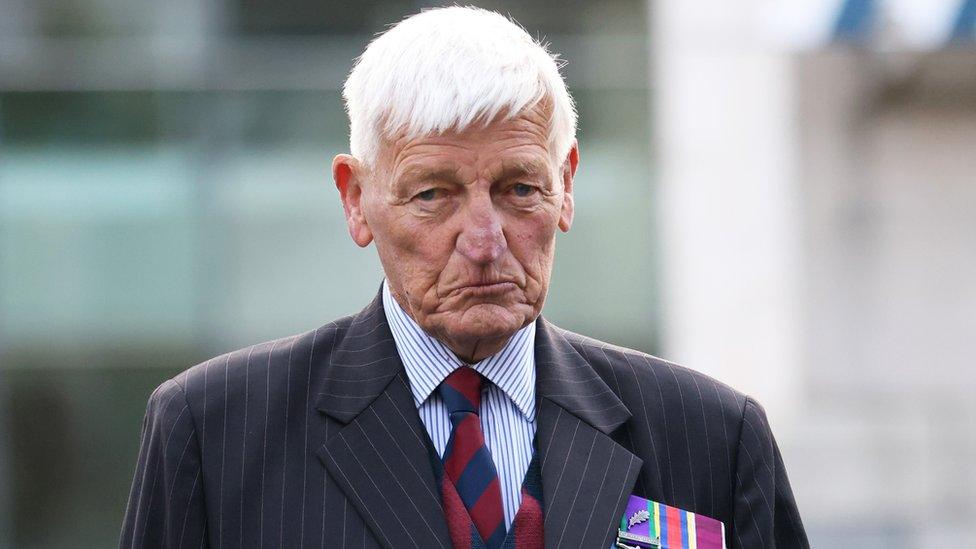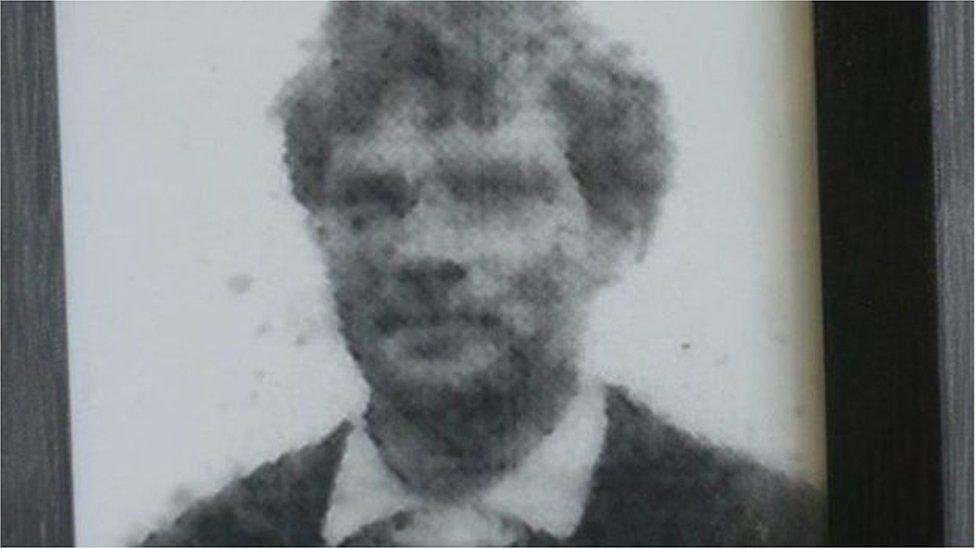Dennis Hutchings: Weapon taken from soldier at scene of killing
- Published

Dennis Hutchings denies charges of attempted murder and attempting to cause grievous bodily harm
The trial of a former soldier has been told that a weapon was taken from the defendant at the scene of a killing in 1974.
However, a witness said he could not be certain that the weapon belonged to Dennis Hutchings.
Mr Hutchings. 80, denies attempting to murder and cause grievous bodily harm to John Pat Cunningham.
The victim, who had a learning difficulty, was shot and killed in a field along the Armagh-Tyrone border.
A former military police officer, Alan Mews, told the trial that he went into the field with a priest and when he checked the victim he "could not see any life".
Mr Mews said he cannot remember having conversations with any of the soldiers present except Dennis Hutchings and he took possession of a rifle, containing 17 rounds of ammunition.
He went on to tell the judge that he could not remember or be sure if the weapon he took possession of belonged to Mr Hutchings.
When asked by the prosecution to explain in general terms why a weapon might be seized at a scene, the witness said this would normally happen if it was suspected that "a weapon had been used".
Mr Mews told the court that he can not remember who might have indicated to him that the weapon had been used.
He said it could have been Mr Hutchings but he could not say for sure, adding "and that is a truthful answer".

John Pat Cunningham was 27 at the time of his death but had a mental age of between six and 10
Another former military police officer has told the trial that he has "no recollection whatsoever of the incident".
The court heard that John Cooper, who is now 74, provided a written statement about the incident in 1974 along with a deposition to the Coroner's Court Inquest, the following year, into the death of Mr Cunningham.
When he was shown his statement and asked if he recognised the signature, he replied: "Yes, that's my signature."
He was then asked if he recognised this as a statement he made. Mr Cooper said: "Yes, I do."
The prosecution asked him if he believes the document is "a truthful statement", Mr Cooper responded: "Yes, I do."
Mr Cooper later added: "Of all the incidents I was involved in in Northern Ireland, I recall virtually none of them."
The judge subsequently ruled that the written and typed version of the 1974 statement and the 1975 Inquest deposition are admissible as evidence.
Mapping evidence
Earlier, the judge ruled that mapping evidence from a deceased police officer can be used in the trial.
The defence had challenged the admissibility of the evidence on the grounds that the particular mapping document did not contain a signature or name.
Defence counsel said it would be unfair to allow the evidence, as the court could not be sure that the document was provided by the late police officer.
However, Mr Justice O'Hara, said it is "entirely safe" to say the late police constable was the author of the document and to suggest otherwise was "fanciful".
John Pat Cunningham, who was 27, was shot in the back and killed, as he ran away from an Army patrol near Benburb in June 1974.
The trial has previously been told that Mr Cunningham had been considered by a doctor as having "an incomplete development of the mind" and being in need of "special care".
The prosecution also explained that the victim, who had the mind of a child, was known to have a fear of the army and people in uniforms and would be expected to run away from patrols.
Dennis Hutchings was on an army patrol near Benburb when Mr Cunningham was shot and killed.
The judge said today that the defence case is that the defendant accepts he was in the field where the victim died, but he does not admit that he fired his weapon.
Mr Justice O'Hara said, in colloquial terms, the defence position is "prove it".
The trial has previously been told that up to five shots were fired at the time of Mr Cunningham's death, three from the defendant's weapon, and two from the rifle of another soldier who is now dead.
The prosecution has also explained that the case against Mr Hutchings is circumstantial and he is not facing a murder charge as there was no forensic evidence to identify which bullets struck the victim.
Related topics
- Published6 October 2021

- Published4 October 2021
